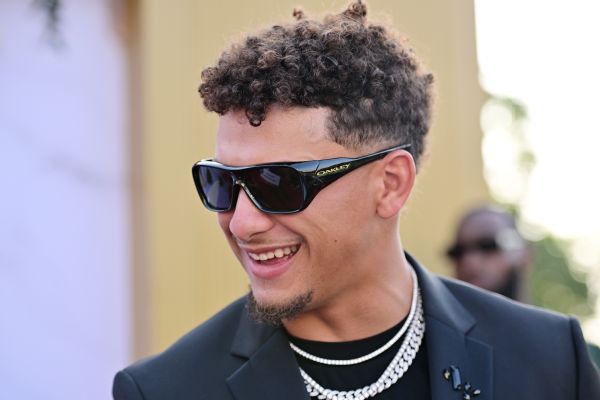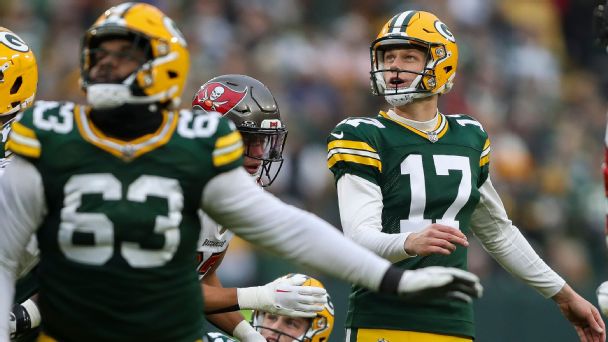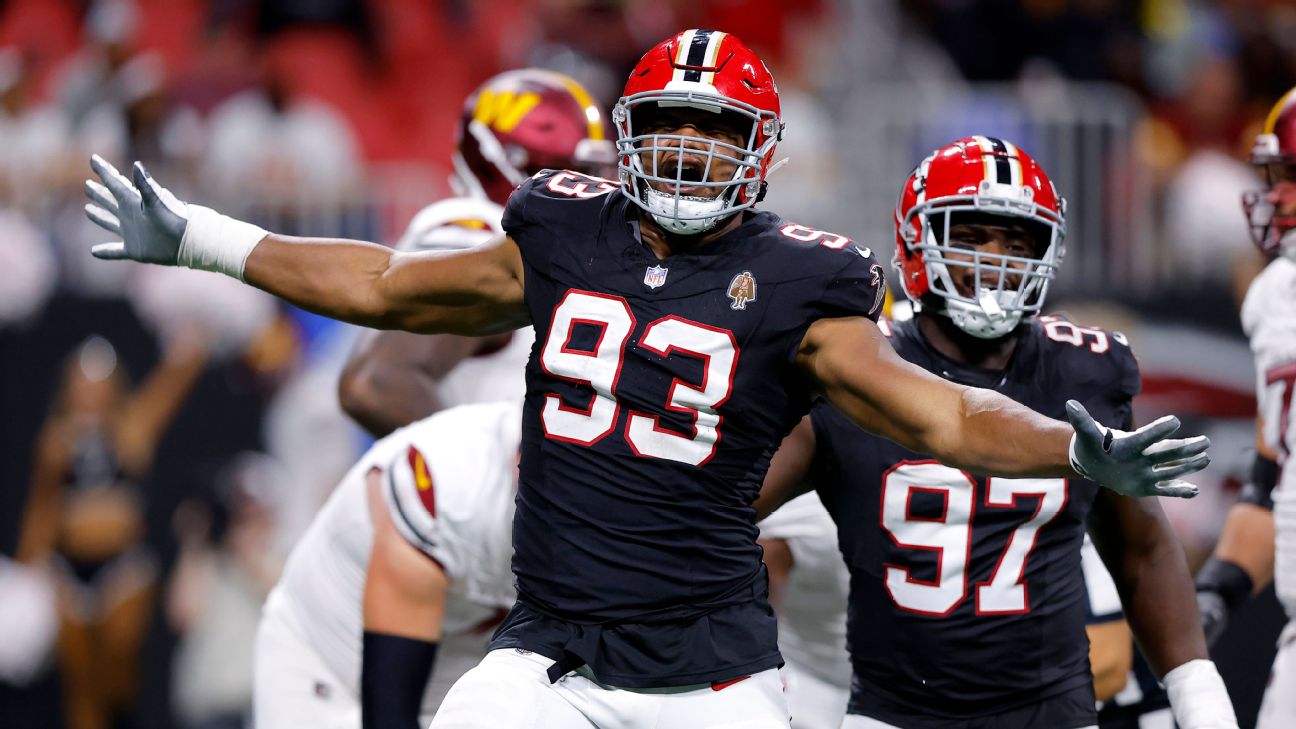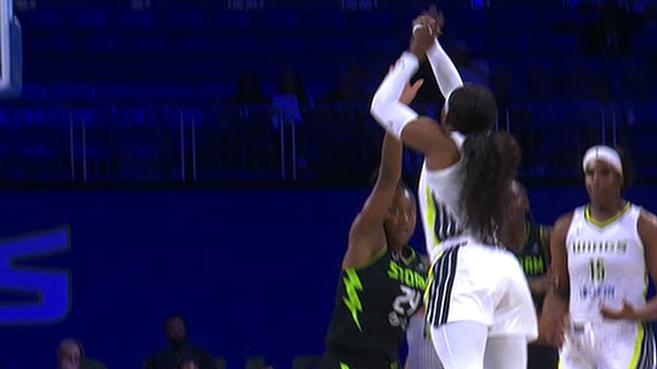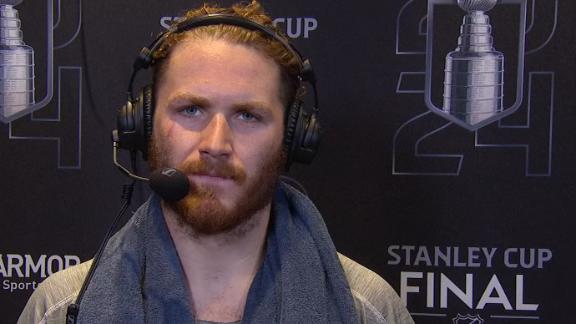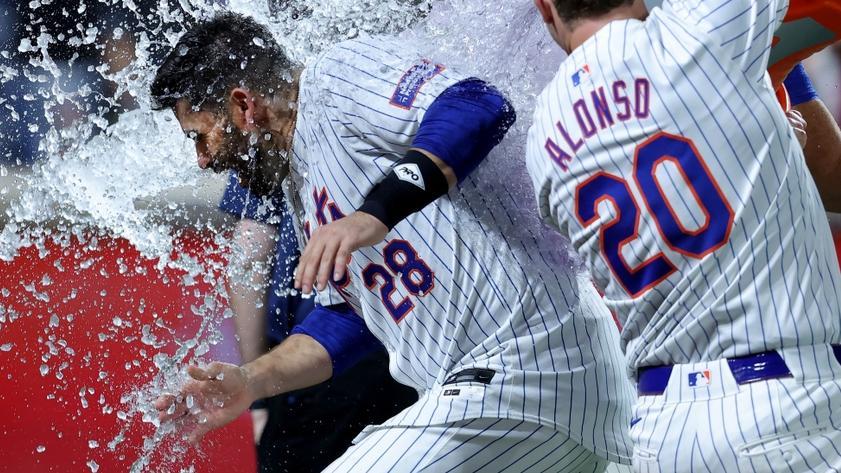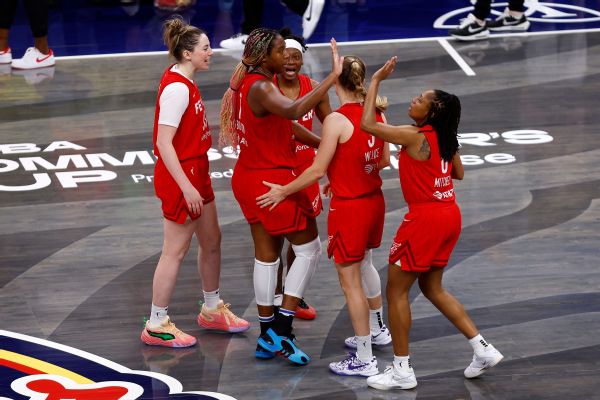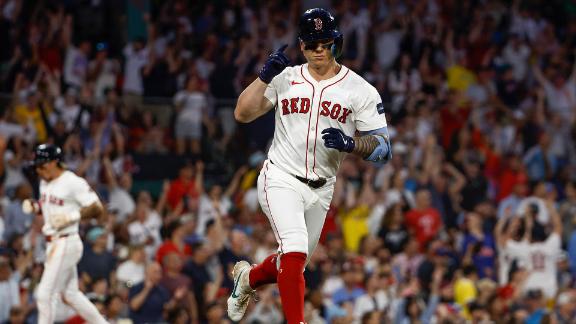![Lowe -- White lede [576x324]](https://a.espncdn.com/photo/2024/0522/r1336275_576x324_16-9.jpg)
SLC team picks Utah Hockey Club as temp name
EARLY IN DERRICK WHITE'S second season -- but really his first, given he spent his rookie year in the G League -- the San Antonio Spurs threw him into the fire as a starter.
In one of White's first starts, on Nov. 15, 2018, against the LA Clippers, he encountered the full Patrick Beverley experience: full-court pressure, unrelenting physicality, roaring trash talk. White struggled badly. The next day, he found a note from assistant coach Chip Engelland in his locker with the date of that game and a message: This is the best thing that has happened to you. It's going to make you better. You'll be different from this day on.
(Some within the Spurs also remember a Fathead of Beverley being placed in White's locker -- some gentle ribbing -- but White does not recall that.)
White kept the note up until the Spurs traded him to the Boston Celtics four-plus years later, he said. "It was humbling," White told ESPN after Boston's comeback win over the Indiana Pacers in Game 1 of the Eastern Conference finals. "This is the NBA. Everyone has a moment like that. I just knew I was gonna keep working."
White emerged in San Antonio as a reliable starter, an important developmental success story for a team trapped in purgatory after trading Kawhi Leonard.
The decision to trade White, then 27, ahead of the 2022 trade deadline was not an easy one for the Spurs, sources said -- even as higher-ups recognized the need to rebuild. White was beloved -- selfless, good at pretty much everything and willing to work hard on his weak spots. Some within the team argued that he was the kind of player the Spurs should want as an organizational exemplar for whatever young guys the coming rebuild would net.
The Spurs did not let go easily when Boston and other teams -- including the Utah Jazz, sources said -- began inquiring about White's availability before the Feb. 2022 trade deadline. One first-round pick would not be enough. White was just starting a four-year, $70-plus million extension.
His 3-point shot needed work, but the Spurs were confident it would click with some mechanical tweaks and a major boost of confidence for a player who always seemed overly deferential -- baggage from being under-recruited in high school and beginning his college career in Division II.
A lot of trade-related focus in the media and within teams coalesces around two sorts of deals: superstar mega-trades, and sinking teams unloading quality veterans. In 2022, Boston's deal for White was a footnote beneath the Brooklyn Nets and Philadelphia 76ers swapping James Harden and Ben Simmons. Several other smaller trades made and not made at that same deadline emerged as critical pivot points for teams -- including the Pacers.
A year later, another deal made from the wreckage of the Nets -- the Phoenix Suns acquiring Kevin Durant -- buried analysis of the New York Knicks flipping one of their first-round picks to the Portland Trail Blazers for Josh Hart. The Knicks, like Boston when the Celtics struck the White deal, were barely over .500. Despite their hoarding extra first-rounders, an average New York team trading its own pick for a shaky-shooting role player seemed to some rival observers as over-exuberant.
Hart, like White, was 27 at the time of the trade. He instantly became a defining Knick. New York was confident it could re-sign Hart on a long-term deal; Hart had told Portland the Knicks were his preferred destination, and the Blazers worked to send Hart there -- never opening trade talks to the entire league, sources said.
The White and Hart deals -- plus the concurrent journey of Caris LeVert in and out of Indiana -- are a reminder that between those extreme trade types, there is a huge middle-ground of smaller deals that can redefine teams that nail them.
In an environment in which most contenders were hand-cuffed in trading future first-round picks, the Celtics and Knicks correctly deduced that their own picks -- even ones likely to end up in the 20s -- carried greater value than usual. Identify the right players, and trades that look to some like gambles and maybe even overpays end up risk-free bargains. What would White net Boston today if they made him available?
Fittingly, the Hart deal involved another wing originally traded around the same time Boston acquired White -- a player who had once been more coveted than both of them.
THE CELTICS HAD scouted White heavily leading into the 2017 draft, when the Spurs ended up selecting him at No. 28. Boston did not have a pick in that range, but they attended Excel Sports Management's pro day in New York to watch White work out and asked Excel if White might come to Boston for a private workout. Excel declined; White, they said, would go before Boston could pick him.
But the Celtics kept watching White from afar. They did not have anyone quite like him in their 2022 guard rotation -- a two-way player with size, passing instincts and a willingness to make snap reads as both playmaker and screener. Kemba Walker was gone. Payton Pritchard was a second-year backup, Dennis Schroder a reserve gunner. Marcus Smart was a little stouter than White on defense, and more scoring-oriented on offense -- making for a delicate balance alongside Jayson Tatum and Jaylen Brown.
Boston in February 2022 was barely over .500, but the team was starting to come together around first-year head coach Ime Udoka and a vice grip defense. Udoka and Will Hardy, now Utah's head coach but then an assistant in Boston, both knew White from their time as Spurs assistants. Both urged Boston to trade for him. Hardy, sources said, was an especially loud proponent.
Tatum, Brown and Smart had all played with White on Team USA during the 2019 FIBA World Cup and spoke highly of him, sources said. Three days after Boston traded for him, Smart invited White to his home to watch the Super Bowl. Tatum was there, too, and made a point to engage White.
"With superstars, you are just waiting to see," said Marcus Mason, who attended the party and has been White's trainer and mentor for nearly two decades. "Jayson spent the whole night with us. He was so inviting. That showed leadership."
The Spurs told all White's suitors that adding second-round picks to a single first-round selection would not be enough. In the last 48 hours before the deadline, Boston offered something interesting: first-round swap rights in 2028, protected for only the No. 1 selection.
The Celtics knew the risks. They had been on the winning side of those kinds of deals with Brooklyn. Both Tatum and Brown could hit unrestricted free agency before 2028, maybe twice. The Spurs' next young core could be rising by then; their 2028 pick might land in the 20s, making any swap more valuable to them.
The Spurs agreed to the deal. They also acquired Josh Richardson, and later flipped Richardson for four second-round picks. The White deal gave them a strong baseline for later trade negotiations surrounding Dejounte Murray; those two deals -- plus good luck -- positioned them to land Victor Wembanyama.
Over that same week in 2022, Indiana made Caris LeVert available. The Pacers had acquired LeVert from the Houston Rockets in 2021 as part of the first Harden deal. The Celtics were not interested in LeVert, sources said.
Nor did they show interest in former Duke standout Cam Reddish, a wayward lottery pick for the Atlanta Hawks who was also available then. New York ended up trading one protected first-round pick for Reddish in January 2022; he logged 653 minutes over two seasons for the Knicks before they offloaded him.
Boston preferred White's quick-twitch passing and defense to LeVert's more ball-dominant scoring. The Cleveland Cavaliers ultimately acquired LeVert, sending Indiana three picks -- one first-rounder and two-second rounders, including what became the No. 31 pick in 2022. (The Cavs had also shown interest in Hart in free agency before the New Orleans Pelicans re-signed him in 2021, sources said.)
The Pacers turned that No. 31 pick into Andrew Nembhard, a critical starter who grinds on defense and has enough on-ball juice to punish teams who hide weak defenders on him. (Unfortunately for Indiana, Boston has none of those.)
The first-round pick Indiana nabbed for LeVert became Ben Sheppard, a key reserve already as a rookie.
WHITE IS THE one player in this constellation who broke out as a star. He earned All-Star consideration this season while averaging 15 points on 47% shooting -- including 39.6% on 3s -- along with 5 assists, 4 rebounds and 2.2 combined steals and blocks. He made his second straight All-Defensive team.
There are rival coaches and executives who argue White was Boston's second-best player this season. He was their best player in the first round against the Miami Heat.
He is more than a role player -- more than even an apex role player. White has run 25.3 pick-and-rolls per 100 possessions, No. 1 on the team -- just ahead of Tatum. He is a good passer, and can provide the kind of pick-and-roll scoring that is typical of more heralded players; White hit 74% at the rim and almost 45% on floaters. He can manufacture points when Boston's offense stalls.
"Not a lot of guys can score 35 one night, take a back seat the next two, and then score 25 again," Mason told ESPN.
Boston's offense doesn't stall as much with White on the floor; he might be the Celtics' best improvisational playmaker and screener -- on and off the ball. Boston's most efficient offense flows out of two-man actions pairing White with Tatum or Brown. When White screens for Boston's superstars, he can zip out in any direction -- drifting for 3s, or slipping to the paint like a rim-running big. Hitting White there on 4-on-3s -- the defense trapping Tatum up high -- almost always ends in a good shot.
Some of that owes to teams slotting their smallest defenders onto White simply because Boston offers no safe hiding place. Most opponents don't want to switch those players onto Tatum and Brown. The only other choice is getting themselves into rotation, which activates Boston's passing game.
Some rival scouts suggest switching is a better tactic, even if it leaves smaller players on Tatum. The thinking is that Boston's offense stagnates, and that Tatum might settle for fadeaways. There has been some truth to that in the past, and even now mixing in switches is probably smart. But Tatum has been more diligent about playing bully ball when he has to.
Another potential counter is putting weaker defenders elsewhere to coax Boston's offense away from the White-Tatum two-man game. The Heat tried this for parts of the first round by stashing Tyler Herro on Brown -- with bigger, more switchable defenders on White. The Golden State Warriors in one regular-season game tried to shift more of Boston's offense toward Brown -- and away from White and Tatum -- by ignoring Brown away from the ball.
The Pacers began Game 1 with the weakest defender -- Tyrese Haliburton -- on Jrue Holiday, likely in part to confuse Boston's path toward those White-centric actions. Holiday brutalized Haliburton in the post; the Pacers toggled Haliburton onto White, and Boston after some aimless stretches refocused its offense around White and Tatum.
None of these actions have teeth without White's mid-career transition from sometimes skittish 3-point shooter into ace gunner. White hit below the league-average on 3s as a Spur. His shot needed some tweaks; White sometimes leaned back and raised his chin instead of staring straight at the rim.
Upon arriving in Boston, White went through slumps in which he was reluctant to shoot. Some if it was his tendency -- the worn-in habit of someone who was never the star -- to defer to bigger-name players. He was also adjusting to a new city and new team -- all while his wife, Hannah, was pregnant with their first child.
Some of it was wavering confidence.
"You miss a couple in a row, and you start thinking," White said. "I was thinking so much, on every shot: Is this really the one to take? Can we get a better one?"
Defenses noticed. They ducked further under screens against White and strayed from him away from the ball. The trickle-down effect hurt Boston's offense; the paint was cluttered and defenses stayed out of rotation.
It was especially glaring for parts of the 2022 conference finals against Miami and then in Boston's six-game Finals loss to the Warriors.
"Basically, they weren't guarding me in the Finals," White said. "You gotta take that personally and grow from it."
White spent that summer working on his shot and internalizing what teammates and coaches were telling him: "Be aggressive. Don't defer to us. [Head coach] Joe Mazzulla was giving me confidence. My teammates were giving me confidence. Hearing stuff like that from great players -- it just gives you confidence."
White hit 38% from deep last season and ratcheted that up to 39.6% on a career-high 6.8 attempts this season. That one change lifted every other part of his game, effectively transforming White into a different player. The increased attention he receives gives him access to more drives and passing reads. Shooting is basketball's meta-skill, interacting with every other subset of offense.
White's development freed Boston to make a seismic move: trading Smart for Kristaps Porzingis and two first-round picks. Three months later, Boston flipped one of those picks to Portland in the Holiday trade. White's growth is a big reason both Porzingis and Holiday are Celtics. White will be eligible this summer for a four-year, $123 million extension. One way or another, sources close to the situation expect him to continue as a core part of the Celtics.
White has transcended the basketball lexicon. He's more than a role player, but not a "star" in the traditional sense -- though advanced metrics characterize him as one, and he can score at star levels here and there when the Celtics need it.
"I'm not into labels," White said. "I don't even know what label I am anymore. I just know that whatever the team needs, I'm ready to do it."


